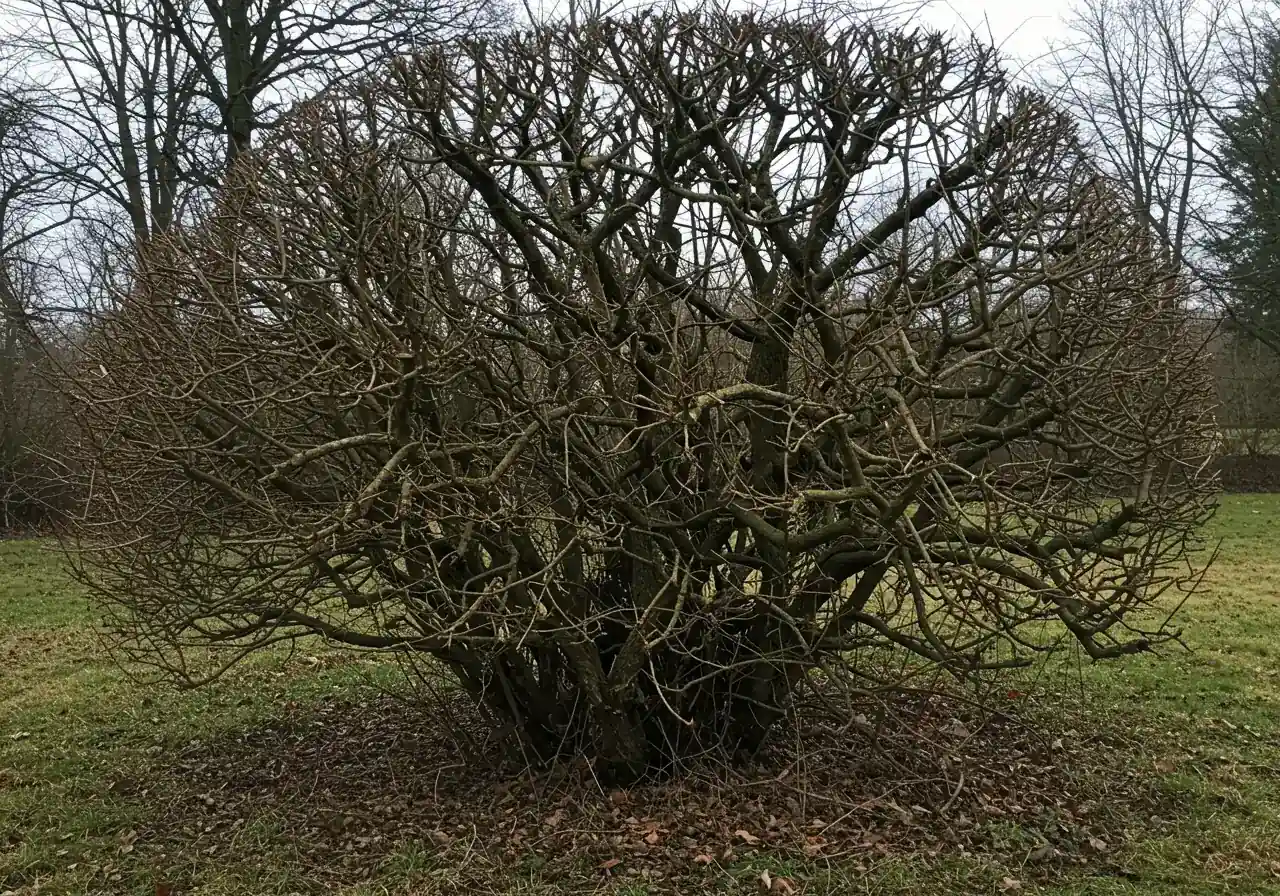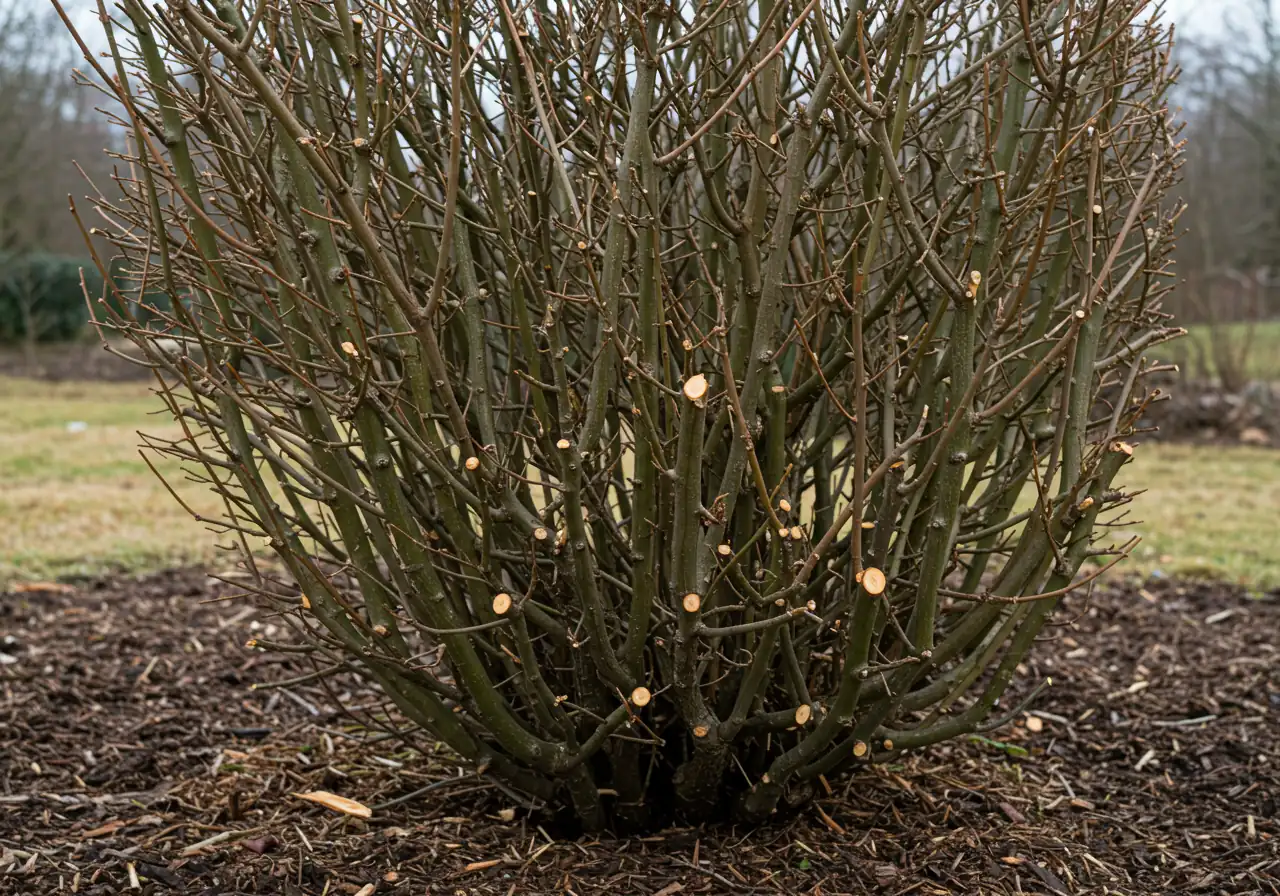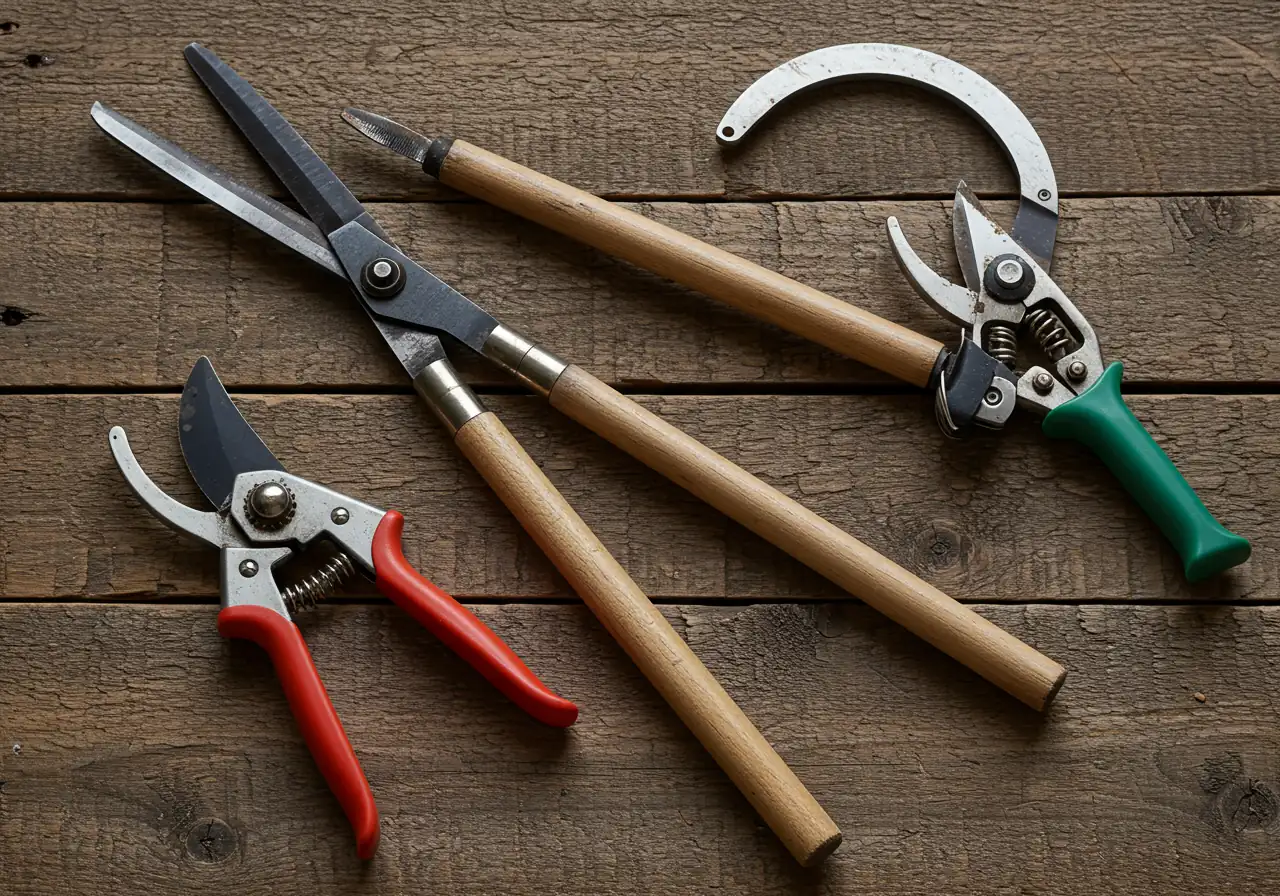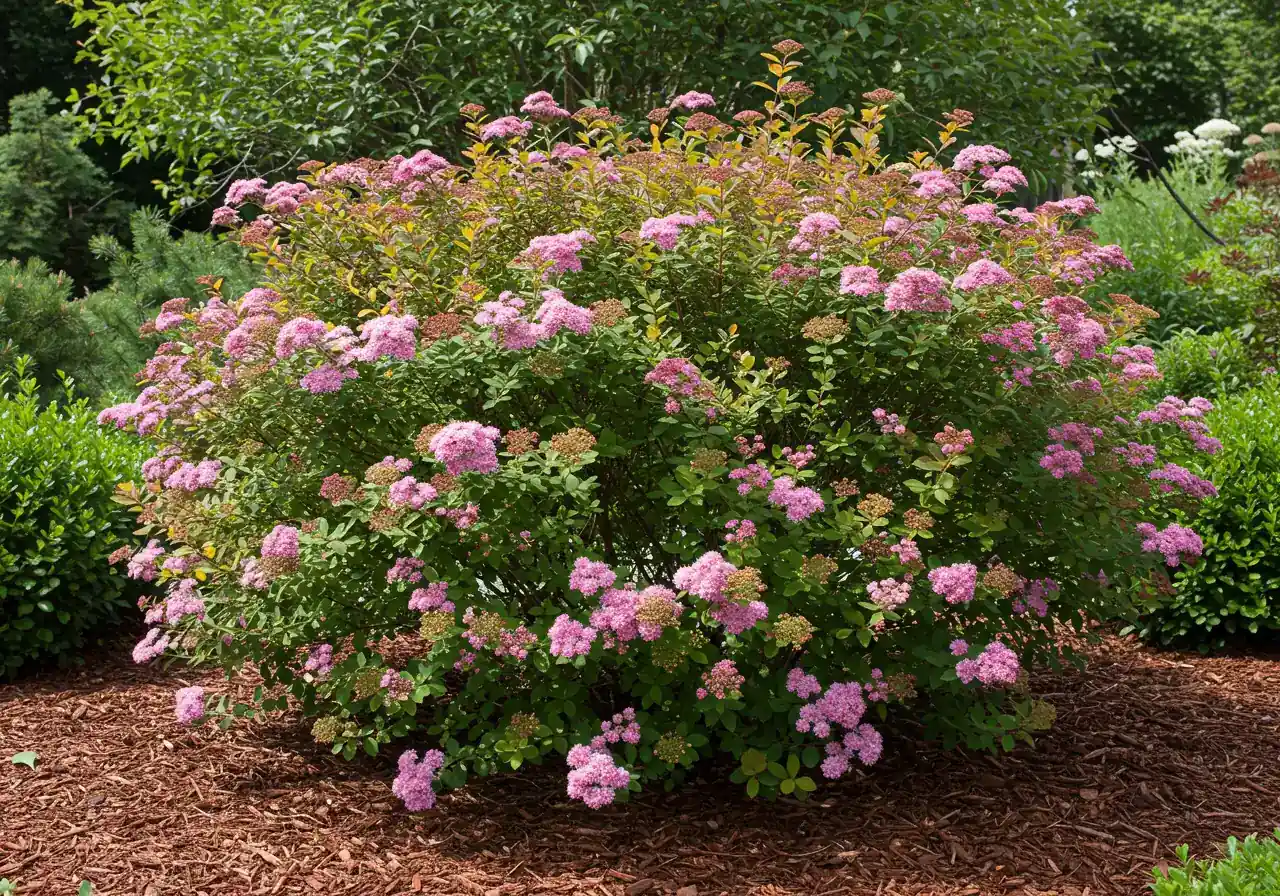Revive Old Vernon Shrubs: Spring Renovation Pruning Guide
Quick Guide to Shrub Renovation:
- What: A pruning technique to rejuvenate old, overgrown shrubs by removing old wood.
- Why: Promotes vigorous new growth, improves shape, increases flowering, enhances plant health.
- When: Late winter/early spring (before leaf-out) for most; *after* flowering for early spring bloomers (Lilac, Forsythia).
- How: Either gradually (1/3 old stems per year) or hard (cut all stems to 6 inches - for suitable shrubs).
- Key Aftercare: Water consistently, apply mulch.
Is your yard looking tired? Overgrown shrubs can make even the nicest Vernon home look neglected. Don't replace them yet! Renovation pruning might be the answer. Need a hand assessing your shrubs? Request a quote today!
Introduction: Breathing New Life into Your Vernon Yard
Hey there, Vernon! Does your yard sometimes feel... well, a bit *vintage*? Maybe those shrubs lining your property look less 'established' and more 'ready for retirement'? We see it all over our beautiful part of the Ottawa region, from here to neighbouring spots like Metcalfe and Greely. Often, older, beloved shrubs get woody, overgrown, and frankly, a little sparse in the middle. They might even look like they're giving up!
But hold off on grabbing the shovel just yet! There’s a fantastic gardening technique that can work wonders: renovation pruning. Think of it as a major spa treatment or a really bold haircut for your tired plants.
So, what is renovation pruning? Simply put, it involves cutting back those old, thick, unproductive branches quite hard, often right down near the ground. This might sound scary, but it encourages the shrub to push out fresh, vigorous new stems from its base or roots. It’s like hitting the reset button! For insights into specific local projects, check out our work on a Manotick garden revival.
The benefits are huge. Your favourite shrub gets a new lease on life, looks dramatically younger, often flowers more profusely, and becomes much healthier and easier to manage in the long run. It's a smart landscaping move to revitalize your green space without starting completely from scratch. Let's explore how to give those veteran plants a much-needed comeback! Proper care extends beyond pruning; learn about soil preparation to give your plants the best foundation.
Is Your Shrub Shouting for Help? Signs It's Time to Renovate
Okay, let's face it. Sometimes our garden shrubs stop looking like proud landscape features and start resembling something a grumpy squirrel built its nest in... ten years ago. They might not actually *shout* (unless you've got some *very* unusual plants in Barrhaven!), but they definitely send signals when they're overdue for a major makeover, also known as renovation pruning.

So, how do you know if your shrub is waving the white flag? Here are the tell-tale signs it’s time to intervene:
- The Deadwood Dilemma: Is your shrub looking more brown than green? An excessive amount of dead branches, especially thick older ones, is a classic sign it needs help. Our tough Ottawa winters can certainly contribute to dieback, making this a common sight. Regular garden maintenance can help manage this.
- Hollow Heart Syndrome: Does the shrub look full on the outside but have a big, empty space in the middle? Older shrubs often get dense on the perimeter, shading out the interior until it becomes bare and twiggy. Think of it as a leafy donut – not usually the desired look in landscaping!
- Flower Failure or Foliage Fizzle: Remember when that lilac used to burst with colour, or that spirea was covered in blooms? If flowering has significantly decreased, or the leaves look sparse and small, the shrub lacks vigour. It’s putting all its energy into just surviving, not thriving. Shrubs weakened by harsh conditions, much like needing an Osgoode Garden Revival After Summer Heat Stress (or winter!), often show these signs first.
- Leggy and Lanky: Is your shrub awkwardly tall and stretched out, with all the greenery way up top? This 'leggy' growth happens when lower branches die off or aren't producing leaves, often due to lack of light or simply old age.
- Just Plain Unruly: Has it become a tangled, overgrown beast that defies any attempt at shaping? Sometimes, shrubs just get *too big* and out of control for their space, losing any attractive form they once had. This kind of situation is exactly why we detail methods for Metcalfe Renovation Pruning to Revive Old Shrubs.
Quick Checklist: Is Your Shrub Crying Out for Renovation?
- Lots of dead branches visible?
- Bare or hollow-looking in the center?
- Significantly fewer flowers or leaves than in past years?
- Awkwardly tall and bare at the bottom (leggy)?
- A tangled, overgrown, or shapeless mess?
Many common shrubs found in Ottawa gardens respond beautifully to renovation pruning. Think Lilacs, Forsythia, Dogwoods (especially the colourful stemmed varieties), Spirea, Potentilla, Weigela, and Ninebark. Before you start, though, having a clear strategy, like a good Manotick Garden Revival Spring Plan, is crucial. Getting the technique right makes all the difference; you can find helpful Kenmore Shrub Renovation Pruning Tips online too. Thinking about a larger property clean up?
If tackling a dramatically overgrown shrub feels overwhelming, remember you don't have to go it alone. Check out our professional Landscaping and Gardening Services – we’re happy to help bring your veteran shrubs back from the brink! Explore our successes in various garden transformations.
Renovation Pruning 101: Ottawa Edition - Choosing Your Strategy
Okay, you’ve spotted the signs, and your shrub is definitely asking for a makeover intervention. But just like deciding between a trim and a whole new 'do, you need a strategy! When it comes to renovation pruning here in the Ottawa area, you generally have two main approaches. Choosing the right one depends on the plant, your patience level, and how drastic you're willing to be.

Let's break down your options:
1. The Gradual Renewal Pruning (The Patient Gardener's Choice)
Think of this as easing your shrub into its new look over three years. It’s less shocking for the plant and for your landscape's appearance.
- How it works: Each year (usually in late winter or early spring before leaves emerge), you remove about one-third of the oldest, thickest stems, cutting them right down to the ground or near the base. Focus on the woodiest, least productive canes first.
- Pros:
- Much less stressful for the shrub.
- The plant maintains its size and presence in your garden throughout the process. No big empty spot!
- Still encourages vigorous new growth from the base.
- Good for shrubs that might react poorly to extreme pruning.
- Cons:
- Takes three years to fully rejuvenate the shrub. Requires patience and remembering what you cut last year!
- You'll need to do this consistently each spring for three years.
- Best suited for: Many multi-stemmed, cane-growing shrubs common in Ottawa gardens like Lilac, Forsythia, Red-Osier Dogwood, Weigela, Mockorange, and Ninebark. It's a gentler approach, which can be beneficial in areas with challenging clay soil, like parts of Barrhaven, where plants might take longer to recover from stress. Consider combining this with our city garden maintenance service for consistency.
2. Hard Rejuvenation Pruning (The "Rip the Band-Aid Off" Method)
This is the bold move – cutting the *entire* shrub down to about 10-15 cm (4-6 inches) from the ground. It sounds harsh, maybe even a little scary, but many shrubs bounce back beautifully.
- How it works: In late winter or early spring, take your sharp loppers or pruning saw and cut *all* stems back close to the ground. Yes, all of them!
- Pros:
- Fastest way to get rid of all the old, unproductive wood at once.
- Results in a flush of vigorous, new, healthy stems.
- Simpler than trying to select specific stems each year.
- Cons:
- Looks *very* drastic initially, leaving a temporary gap in your landscape.
- Can be too stressful for some types of shrubs (see below).
- You might miss a year of flowers depending on the shrub's blooming habits.
- Requires faith! That stubby base *will* regrow (usually!).
- Best suited for: Tough, fast-growing shrubs known to respond well, such as Spirea (most types), Potentilla, Hydrangea arborescens ('Annabelle' types) and Hydrangea paniculata ('Limelight', 'Quick Fire'), and colourful Dogwoods if you *really* want to maximize stem colour. After such drastic cutting, giving the plant a boost with good proper soil preparation and amendment around its base is a great idea to fuel that regrowth. If the gap left behind is too much, you could temporarily fill the space with annuals, or even consider a fresh garden installation if you decide the shrub isn't worth saving after all.
Important Note: Who *Not* to Prune This Way!
*Never* use these renovation techniques on:
- Evergreens: Plants like cedars (Thuja), junipers, yews, pines, and spruce generally won't regrow from old wood if cut back hard. You'll likely kill them or leave permanent bare spots.
- Shrubs that form a single trunk or tree-like structure.
- Some shrubs that bloom *only* on old wood and don't readily send up new shoots from the base (like some Rhododendrons or Azaleas, though winter hardiness is often the bigger issue for these in Ottawa anyway). Always check your specific plant type if unsure!
Aftercare is Key
Whichever method you choose, remember that pruning stimulates growth, which requires energy. Ensure your recovering shrub gets adequate water, especially during dry spells. A layer of mulch and maybe a dose of balanced fertilizer once growth starts can help immensely. Dealing with the pruned branches? That's where an expert garden clean-up in Vernon can save you time and effort.
Choosing the right strategy might seem daunting, but seeing the rewarding results our clients appreciate makes it all worthwhile. If you're feeling unsure about tackling a beloved but overgrown plant, considering professional landscaping and gardening services is always a smart option. We can help you choose and execute the best plan for your specific shrubs and situation. We offer services across Ottawa, including specific Metcalfe property cleanup service.
Quick Comparison: Gradual vs. Hard Pruning
| Feature | Gradual Renewal Pruning | Hard Rejuvenation Pruning |
|---|---|---|
| Speed | Slow (3 years for full cycle) | Fast (results seen in one season) |
| Appearance | Maintains shrub presence | Creates temporary empty space |
| Plant Stress | Lower | Higher |
| Effort | Annual selection of stems needed | One-time major cut |
| Best For | Lilac, Forsythia, Dogwood, Weigela | Spirea, Potentilla, tough Hydrangeas |
| Risk | Lower risk of plant loss | Higher risk if plant is unsuitable |
Gradual Renewal Pruning Steps
Ideal for less shock and maintaining garden presence. Good for Lilacs, Forsythia, Dogwoods.
- Year 1: Remove 1/3 oldest, thickest stems at base.
- Year 2: Remove another 1/3 of the remaining old stems.
- Year 3: Remove the final 1/3 of the original old stems.
- Ongoing: Light annual pruning for shape and deadwood removal.
Hard Rejuvenation Pruning Steps
Fastest method for tough, vigorous shrubs like Spirea, Potentilla.
- Action: Cut *all* stems to 4-6 inches (10-15 cm) from the ground in late winter/early spring.
- Result: Creates a temporary bare spot but results in all-new growth.
- Caution: Only suitable for specific shrub types; not for evergreens.
Essential Pruning Tools
Using the right tools ensures clean cuts and safety.

- Bypass Pruners: For stems up to thumbnail thickness.
- Loppers (Bypass): For stems up to 1.5 inches thick. Long handles provide leverage.
- Pruning Saw: For very thick, old stems.
- Safety Gear: Always wear sturdy gloves and eye protection!
Timing is Crucial: The Best Window for Spring Pruning in Ottawa
Alright, let's talk timing. When it comes to giving your shrubs that big renovation haircut, *when* you do it is almost as important as *how* you do it. Get the timing wrong, and you might stress the plant or, gasp, miss out on those lovely spring flowers! Here in Ottawa, with our notoriously dramatic seasons, hitting the sweet spot is key.
The Golden Window: Late Winter to Early Spring
For *most* shrubs that benefit from renovation pruning (we'll get to the exceptions!), the ideal time in the Ottawa region (generally USDA Zone 5a/5b) is late winter to very early spring. Think late March through mid-April, right after the worst of the winter frost danger seems to have passed but *before* the buds really start swelling and leafing out.
Why then? Let’s break it down:
- Sleeping Beauties: Your shrubs are still mostly dormant. Pruning them now is less stressful as they've stored energy in their roots.
- See-Through Structure: Without leaves, it’s easier to see the shrub's framework and identify old stems.
- Beat the Bugs (and Diseases): Cuts have time to heal before pests and diseases become highly active. More info on plant health can be found by consulting with experts like the Master Gardeners of Ontario.
- Fueling the Comeback: Pruning before spring growth directs energy into producing vigorous new shoots.
Hold Your Horses! The Exception: Early Spring Bloomers
Now, here’s the big *but*! If your shrub puts on its big flower show early in spring (think Forsythia with its bright yellow blooms, or classic Lilacs), pruning it in late winter/early spring means you'll be cutting off the flower buds for the current year. Oops! For these early bloomers, the rule is different: Prune them *immediately after* they finish flowering. This gives them the whole growing season to produce new stems and set buds for next year's display.
Microclimate Musings & Local Variations
Keep in mind that even within the Ottawa area, timing can vary slightly. A sheltered spot in Kars near the river might warm up a touch sooner than an exposed hilltop garden out near Metcalfe. The best advice? Keep an eye on *your* specific plants and the local weather forecast (check resources like Environment Canada for Ottawa). Wait until the snow has mostly melted from around the base of the shrub and daytime temperatures are consistently starting to stay above freezing.
Practical Tip: Make a Simple Calendar
Jot down your main shrubs and note whether they bloom on old or new wood. This helps create a simple seasonal reminder for your pruning tasks. Remember, consistent care, including pruning and attention to things like thriving lawn care, contributes to a healthy overall landscape. A rejuvenated shrub can look fantastic, perhaps even inspiring a fresh garden installation nearby to complement its new look!
And don't forget the cleanup! Renovation pruning can generate a surprising amount of branch debris. If you're facing a mountain of cuttings, consider getting help. Whether you're looking for a specific Metcalfe property cleanup service or a more general Ottawa property cleanup service, professional help can save you time and hassle. As with any service, it's always smart to glance over the provider's terms and conditions so you know what to expect.
Get Clipping: Your Step-by-Step Renovation Pruning Guide

Alright, you've chosen your strategy and picked the right time – now it's time to get clipping! Don't worry, this isn't complicated rocket science, just good gardening sense. Think of it as giving your shrub a much-needed spa day, Ottawa style. Ready to roll up your sleeves?
First Things First: Gear Up for Safety and Success
Before you make the first cut, let's gather the essentials and talk safety. You wouldn't start a kitchen reno without the right tools, right? Same goes for landscaping!
- Essential Tools:
- Bypass Pruners: For smaller stems (up to thumbnail thickness). Keep 'em sharp!
- Loppers: Long-handled bypass loppers for thicker stems (up to ~1.5 inches).
- Pruning Saw: For the really thick, old canes.
- Safety Gear (Non-negotiable!):
- Sturdy Gloves: Protect your hands.
- Eye Protection: Safety glasses or goggles are a must.
- Sensible Shoes: Closed-toe for protection and stability.
Step 1: Assess & Plan
Identify old wood. Choose Gradual or Hard Pruning based on shrub type and desired outcome. Confirm timing (late winter/early spring for most).
Step 2: Make the Cuts
Use sharp tools. Cut 1/3 oldest stems (Gradual) or all stems to 4-6" (Hard). Make clean, angled cuts near the base or an outward bud.
Step 3: Aftercare & Cleanup
Water well. Apply mulch. Wait for growth before light fertilizing (optional). Dispose of branches via compost, City green bin, or hire a cleanup service like our city yard cleanup service.
Method 1: Gradual Renewal Pruning (The Patient Approach)
Remember, this is the three-year plan.
- Year 1: Identify and remove about one-third of the oldest, thickest stems, cutting close to ground level.
- Year 2: Repeat, removing another third of the remaining oldest stems. New growth should be visible.
- Year 3: Remove the last third of the original old stems. Continue light annual pruning.
Method 2: Hard Rejuvenation Pruning (The Bold Move)
This is quicker but looks dramatic initially. Best for tough cookies like Spirea or Potentilla.
- The Big Chop: Using loppers or saw, cut *all* stems back to about 10-15 cm (4-6 inches) from the ground. Make clean cuts.
- Aftercare Boost: Ensure adequate water, especially in dry spells. Applying quality mulch is highly recommended. Good mulching and edging helps retain moisture. Unsure about materials? Explore material selection options.
Making the Cut (Literally!)
- Angle: Make cuts at a slight 45-degree angle, sloping away from a bud or the centre.
- Cleanliness: Sharp tools make clean cuts, reducing disease risk.
A Note on Ottawa Soils:
Some areas, like parts of Barrhaven or Greely, have heavy clay soil. Plants recovering from hard pruning in clay might benefit from adding compost around their base before mulching to improve drainage.
The Aftermath: Cleanup Time!
Renovation pruning creates debris. Options include composting disease-free branches, bundling for municipal pickup (check City of Ottawa rules), or hiring pros. For larger jobs, consider an Ottawa property cleanup service or our local Metcalfe yard cleanup service. Need feedback on estimates? See client feedback here.
Now, step back and admire your work (or the potential in those stubs!). You've given your shrub a fantastic chance at a vibrant second act. Happy pruning!
Typical Vigor Boost After Renovation*
*Illustrative percentage increase in new growth density/vigor in the first season post-renovation.
After the Cut: Post-Pruning Care & Eco-Friendly Tips
Okay, the deed is done! You’ve braved the snips and saws. Now comes the equally important part: the aftercare. Think of it as post-surgery recovery for your plant.
Water Wisely: Quenching Thirsty Roots
After pruning, especially hard rejuvenation, your shrub needs consistent moisture. Give it a deep soaking right after pruning. Keep the soil consistently moist, but not waterlogged, during the first growing season, especially during dry Ottawa summers. Water deeply less often to encourage deeper roots.
Mulch Magic: The Gardener's Secret Weapon
Apply a 2-3 inch layer of organic mulch (shredded bark, wood chips) around the base (not touching stems). Mulch retains moisture, suppresses weeds, and moderates soil temperature. It’s great for Ottawa’s clay soils. Explore the benefits of professional mulching and edging.
Feeding Time? Go Easy!
Hold off on fertilizer immediately. Wait for strong new growth. If needed, use a balanced, slow-release fertilizer or top-dress with compost. Over-fertilizing can force weak growth. Consistent care is key, often part of a regular city garden maintenance service.
Dealing with the Debris: Eco-Friendly Ottawa Options
Renovation pruning creates branches! Options:
- Compost It: Chop smaller, disease-free branches for your compost.
- Green Bin/Yard Waste: Follow City of Ottawa guidelines for bundling or bagging.
- Chip It: Turn branches into valuable mulch with a chipper.
- Call for Backup: For large amounts, an Ottawa garden clean up service is efficient. For bigger jobs, consider a full property clean up. Maybe you need help in Marionville? We offer Marionville garden clean up too.
Patience, Grasshopper
After hard pruning, your shrub might look stark. Have faith! Provide care and watch for green buds. Supporting plant health is our goal; learn more about Clean Yards. Soon, you'll have a healthier shrub. Check out our Google My Business page for reviews!
Quick Tips for Renovation Success
- Time it Right (Mostly!): Late winter/early spring (Mar-Apr) before leaf-out. *Exception:* Prune early bloomers (Lilac, Forsythia) right *after* flowering.
- Pick Your Pruning Path: Gradual (1/3 old stems/year for 3 years) or Hard (cut all to 6" - for tough shrubs like Spirea, Potentilla). *Not* for evergreens!
- Use Sharp & Safe Tools: Bypass pruners, loppers, maybe a saw. Always wear gloves and eye protection!
- Aftercare Essentials: Water & Mulch: Keep soil moist. Apply organic mulch (great for clay soil areas like parts of Nepean).
- Plan Your Cleanup Crew: Compost, bundle for City pickup, or hire pros like a city garden clean up service or even a broader city property cleanup service.
- Patience is a Virtue: Hard-pruned shrubs look bare initially. New growth will come! See inspiring garden transformations.
- Frame Your Masterpiece: Consider enhancing the surroundings. Does the lawn need professional sod installation? Learn about our team if you need help.
FAQs: Your Ottawa Shrub Renovation Questions Answered
Hey, it's totally normal to feel a bit nervous wielding those loppers! But for the *right* kind of shrub – think hardy Ottawa favourites like Lilacs, Dogwoods, Spirea, Potentilla – renovation pruning is usually more like a spa treatment than a death sentence. Cutting back old wood encourages vigorous new growth from the base. Of course, if a shrub is already super stressed or very, very old, it might struggle. But generally, for overgrown but otherwise okay plants, it's a fantastic way to bring them back to life. Just *don't* try this on evergreens like cedars or junipers!
Oops! It happens to the best of us gardeners, especially with Ottawa's unpredictable springs. Pruning an early spring bloomer like Forsythia or Lilac *before* it flowers means you likely snipped off this year's flower buds. The good news? The shrub itself will almost certainly be fine! It’ll probably put out lots of healthy green growth this season. You’ll just miss the yellow flower show *this year*. Make a note to prune it right *after* the flowers fade next spring, and you'll be golden (literally!).
Take a deep breath! We promise, that stark, twiggy look is totally normal after hard rejuvenation. It definitely requires a leap of faith the first time! If you cut back a tough plant like Potentilla or certain Spireas hard in early spring, those "sad sticks" are just waiting for the signal to burst into growth. Keep it watered, maybe add some mulch, and be patient. You should see new green shoots appearing soon. It looks drastic now, but you're on track for a much fuller, healthier shrub later!
Great question! Patience is definitely part of the process. If you chose the *gradual* method (removing 1/3 of old stems each year for 3 years), your shrub never really looks bare. If you did the *hard* cut-down, expect to see vigorous new shoots emerging within weeks of warm weather arriving. By mid-summer, you should have quite a bit of regrowth – maybe 1-2 feet tall, depending on the shrub and conditions. To get back to a substantial *size*, it might take 2-3 growing seasons, especially with our Ottawa climate and sometimes heavy clay soil like in parts of Barrhaven. Local horticultural groups like the Barrhaven Horticultural Society might offer specific local advice.
We strongly recommend *not* using hedge trimmers for this job. Hedge trimmers are designed for light shearing of outer leaves and thin twigs. Renovation pruning involves cutting thick, old, woody stems, sometimes right at ground level. Hedge trimmers just aren't built for that – you'll likely damage the tool, make ragged cuts that heal poorly and invite disease, and frankly, it won't work well. Stick with sharp bypass pruners, loppers, and maybe a pruning saw for the heavy lifting. Clean cuts are crucial for recovery. Plus, the branch cleanup is different; for major debris, sometimes calling a professional Marionville yard cleanup service is the easiest way to handle it.
Unfortunately, cedar hedges (Thuja) and most other evergreens are *not* candidates for hard renovation pruning. They generally don't regrow from old, bare wood. Cutting them back severely will likely leave permanent holes or even kill them. Regular, light shearing is the way to maintain cedars. If your hedge in Manotick is truly beyond saving or way too big, removal might be the practical solution. Sometimes this task can be included as part of a broader Marionville property cleanup service if you have other areas needing attention. After removal, you could replant with something new or consider improving the area with expert sod installation for a clean, green space. When engaging any service, it's good practice to know how your personal information is used; feel free to review our approach in our Privacy Policy.
Conclusion: Enjoy Your Rejuvenated Vernon Oasis!

So there you have it! Renovation pruning might sound intense, but it’s really just giving your older shrubs a chance to hit the reset button and shine again. We’ve covered how to spot the signs your plant needs help, the difference between gradual renewal and a bold hard prune, why timing your cuts in late winter/early spring (usually!) is key for Ottawa gardens, and the essential aftercare steps like watering and mulching. Think of it as swapping out tired, woody branches for fresh, vibrant growth – a true landscaping glow-up!
Taking on a big pruning project can transform a scraggly shrub back into a beautiful focal point, adding life and value to your Vernon property, or anywhere from Kars to Kenmore and Winchester. Imagine stepping outside to a yard that feels truly refreshed and alive – your own personal oasis. For more cleanup options see our Ottawa yard cleanup service page.
Feeling inspired but maybe a little hesitant to make those first big cuts? Or perhaps you'd rather leave the heavy lifting (and branch hauling!) to the experts? We get it! If you’re in Vernon, or the wider Ottawa area including Marionville, and want professional help bringing your shrubs back from the brink, Clean Yards is here for you. Contact us today to discuss our Landscaping and Gardening Services, including expert shrub renovation pruning. Let’s get your garden looking gorgeous again!

